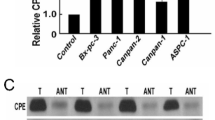Abstract
It has been previously shown that the simultaneous exposure of colon cancer cells MIP to irinotecan and secreted protein acidic and rich in cysteine (SPARC) enhances anticancer activity. However, whether there is same effect of SPARC in pancreatic cancer remains largely unknown. Therefore in this study, we aimed to investigate the role of SPARC played in the sensitivity of pancreatic cancer to gemcitabine. We first treated MIAPaCa2 and MIAPaCa2/SPARC69 cells with different concentrations of gemcitabine (2, 5, 10, and 20 μM) for 24, 48, and 72 h and selected the appropriated concentration for further study. Then we analyzed cell viability, cell cycle, and apoptosis and the levels of apoptosis-related proteins by 3-(4,5-dimethylthiazol-2-yl)-2,5-diphenyltetrazolium bromide, fluorescence-activated cell sorting and Western blot were used, respectively. In this study, we found that gemcitabine inhibited the proliferation of pancreatic cancer cells in a time- and dose-dependent manner. Overexpression of SPARC increased the inhibiting effect of gemcitabine on pancreatic cancer cells. The colony size of MIAPaCa2/SPARC69 was much smaller than that of MIAPaCa2/V. There was a G0/G1 arrest with significant increase of apoptosis after gemcitabine treatment in MIAPaCa2/SPARC69 cells. Furthermore, our results demonstrated that overexpression of SPARC markedly increased the levels of pro-apoptotic proteins in gemcitabine-treated pancreatic cancer cells. The SPARC can enhance the chemosensitivity of pancreatic cancer cells to gemcitabine via regulating the expression of apoptosis-related proteins. These results have shown that the SPARC/ gemcitabine combination treatment may be a potentially useful therapeutic option for individuals diagnosed with pancreatic cancer






Similar content being viewed by others
References
Hariharan D, Saied A, Kocher HM. Analysis of mortality rates for pancreatic cancer across the world. HPB (Oxford). 2008;10(1):58–62.
Chang MC, Wong JM, Chang YT. Screening and early detection of pancreatic cancer in high risk population. World J Gastroenterol. 2014;20(9):2358–64.
Antoniou G, Kountourakis P, Papadimitriou K, Vassiliou V, Papamichael D. Adjuvant therapy for resectable pancreatic adenocarcinoma: review of the current treatment approaches and future directions. Cancer Treat Rev. 2014;40(1):78–85.
Infante JR, Matsubayashi H, Sato N, Tonascia J, Klein AP, Riall TA, et al. Peritumoral fibroblast SPARC expression and patient outcome with resectable pancreatic adenocarcinoma. J Clin Oncol. 2007;25(3):319–25.
Chen G, Tian X, Liu Z, Zhou S, Schmidt B, Henne-Bruns D, et al. Inhibition of endogenous SPARC enhances pancreatic cancer cell growth: modulation by FGFR1-III isoform expression. Br J Cancer. 2010;102(1):188–95.
Zhang FX, Yang L, Li ZS, Zhang L, Gao J, Gong YF. SPARC gene expression in pancreatic cancer cell lines of its promoter methylation Ningxia. Med J. 2008;30(12):1087–8.
Sato N, Fukushima N, Maehara N, Matsubayashi H, Koopmann J, Su GH, et al. SPARC/osteonectin is a frequent target for aberrant methylation in pancreatic adenocarcinoma and a mediator of tumor-stromal interactions. Oncogene. 2003;22(32):5021–30.
Puolakkainen PA, Brekken RA, Muneer S, Sage EH. Enhanced growth of pancreatic tumors in SPARC-null mice is associated with decreased deposition of extracellular matrix and reduced tumor cell apoptosis. Mol Cancer Res. 2004;2(4):215–24.
Chen J, Wang M, Xi B, Xue J, He D, Zhang J, et al. SPARC is a key regulator of proliferation, apoptosis and invasion in human ovarian cancer. PLoS ONE. 2012;7(8):e42413.
Mason IJ, Taylor A, Williams JG, Sage H, Hogan BL. Evidence from molecular cloning that SPARC, a major product of mouse embryo parietal endoderm, is related to an endothelial cell ‘culture shock’ glycoprotein of Mr 43,000. EMBO J. 1986;5(7):1465–72.
Brekken RA, Sage EH. SPARC, a matricellular protein: at the crossroads of cell-matrix communication. Matrix Biol. 2001;19(8):816–27.
Tai IT, Dai M, Owen DA, Chen LB. Genome-wide expression analysis of therapy-resistant tumors reveals SPARC as a novel target for cancer therapy. J Clin Invest. 2005;115(6):1492–502.
Saif MW. Pancreatic cancer: is this bleak landscape finally changing? Highlights from the ‘43rd ASCO Annual Meeting’. Chicago, IL, USA. June 1–5, 2007. JOP. 2007;8(4):365–73.
Fulda S, Debatin KM. Apoptosis signaling in tumor therapy. Ann N Y Acad Sci. 2004;1028:150–6.
Yang BF, Lu YJ, Wang ZG. MicroRNAs and apoptosis: implications in the molecular therapy of human disease. Clin Exp Pharmacol Physiol. 2009;36(10):951–60.
Bast A, Krause K, Schmidt IH, Pudla M, Brakopp S, Hopf V, et al. Caspase-1-dependent and -independent cell death pathways in Burkholderia pseudomallei infection of macrophages. PLoS Pathog. 2014;10(3):e1003986.
Chan JM, Ho SH, Tai IT. Secreted protein acidic and rich in cysteine-induced cellular senescence in colorectal cancers in response to irinotecan is mediated by P53. Carcinogenesi. 2010;31(5):812–9.
Mao Z, Ma X, Fa X, Cui L, Zhu T, Qu J, et al. Secreted protein acidic and rich in cysteine inhibits the growth of human pancreatic cancer cells with G1 arrest induction. Tumor Biol. 2014;35(10):10185–93.
Acknowledgments
The authors would like to thank Dr. Shi Lei (Chi Biotechnology) for critical reading. This work was sponsored by The natural science foundation of Jiangsu Province (Youth Fund), grant number BK20130475; Zhenjiang Science and Technology Pillar Program, grant numbers SH2012030, SH2012031, and SH2014035; The Foundation for Young Scientists of affiliated Hospital of Jiangsu University (grant number JDFYRC2013009); post-doctoral research funding schemes of Jiangsu Province (grant number 1302096B); and Research innovation project of Jiangsu Province General University Graduate (CXLX13-688).
Conflicts of interest
None
Author information
Authors and Affiliations
Corresponding author
Additional information
Xin Fan and Zhengfa Mao contributed equally to this work.
Rights and permissions
About this article
Cite this article
Fan, X., Mao, Z., Ma, X. et al. Secreted protein acidic and rich in cysteine enhances the chemosensitivity of pancreatic cancer cells to gemcitabine. Tumor Biol. 37, 2267–2273 (2016). https://doi.org/10.1007/s13277-015-4044-4
Received:
Accepted:
Published:
Issue Date:
DOI: https://doi.org/10.1007/s13277-015-4044-4




